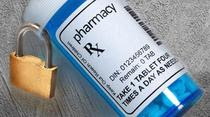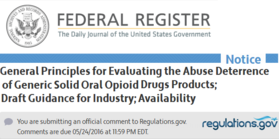

FDA announces enhanced warnings for immediate-release opioid pain medications related to risks of misuse, abuse, addiction, overdose and death
In a continuing effort to educate prescribers and patients about the potential risks related to opioid use, the U.S. Food and Drug Administration today announced required class-wide safety labeling changes for immediate-release (IR) opioid pain medications. Among the changes, the FDA is requiring a new boxed warning about the serious risks of misuse, abuse, addiction, overdose and death. Today’s actions are among a number of steps the agency recently outlined in a plan to reassess its approach to opioid medications. The plan is focused on policies aimed at reversing the epidemic, while still providing patients in pain access to effective relief.
The FDA is also requiring several additional safety labeling changes across all prescription opioid products to include additional information on the risk of these medications. This is part of the agency’s overall effort to help inform prescribers about the importance of balancing the serious risks of opioids with their role in managing pain. More information
|

FDA proposes ban on most powdered medical gloves
FDA announced a proposal to ban most powdered gloves in the United States. While use of these gloves is decreasing, they pose anunreasonable and substantial risk of illness or injury to health care providers, patients and other individuals who are exposed to them, which cannot be corrected through new or updated labeling.
The proposed ban applies to powdered surgeon’s gloves, powdered patient examination gloves and absorbable powder for lubricating a surgeon’s glove. More information
|

Eye Drops: FDA Statement - Potential Risk of Loose Safety Seals
FDA is warning the public about eye drop bottles that have loose plastic safety seals or tamper evident rings below the bottle cap that may fall onto the eye when the product is used. See Safety Statement for example photo. FDA has received reports of six adverse events associated with loose safety seals on eye drop bottles. FDA is in the process of identifying all relevant products and will require a change in the packaging design.
Best Bentonite Clay by Best Bentonite: FDA Alert - Risk of Lead Poisoning
FDA is warning consumers not to use “Best Bentonite Clay,” a product of Best Bentonite, located in Guthrie, Oklahoma. FDA has determined that the product contains elevated lead levels and may pose a lead poisoning risk. FDA laboratories have found elevated levels of lead in “Best Bentonite Clay.” Exposure to lead can cause serious damage to the central nervous system, kidneys, and immune system. In children, chronic exposure to lead, even at low levels, is associated with cognitive impairment, reduced IQ, behavioral difficulties, and other problems. More information
NOW Health Group Dietary Supplements: Recall - Mislabeling
NOW Health Group, Inc. is recalling limited quantities of six dietary supplements that are mislabeled due to a printing error from the label supplier. The recall affects approximately 165 total units that were distributed nationally and sold in retail stores and online. No other NOW products are affected or are involved in this recall.
Two of the products, Goldenseal Root 500mg 100 caps - Product Code 4692, Lot #1961645 and Cranberry Ext Caps 90 VegCaps - Product Code 4632, Lot #1961645, have undeclared allergens (SOY). People who have an allergy or severe sensitivity to soy run the risk of serious or life-threatening allergic reaction if they consume these products. More information
OxySure Portable Emergency Oxygen System, Model 615 by OxySure Therapeutics, Inc: FDA Safety Communication - Do Not Use
The FDA is recommending consumers, businesses, schools, and health care providers stop using OxySure Portable Emergency Oxygen System, Model 615 because of several device malfunctions, including ineffective oxygen delivery, and chemical reactions in the canisters that could cause them to explode.
Due to adverse event reports to the FDA and the company’s failure to address the device’s safety issues noted during inspections and in the FDA’s warning letter, the FDA is concerned that patients and other users of OxySure Portable Emergency Oxygen System, Model 615 are at risk for serious adverse health consequences, such as burns and death. More information
|
Comunicaciones de la FDA sobre la seguridad de los medicamentos en español
Descargo de responsabilidad: La FDA reconoce la necesidad de proporcionar información importante sobre seguridad de los medicamentos en idiomas distintos al inglés. Hacemos lo mejor posible para proporcionar versiones en español precisas y oportunas de nuestras Comunicaciones de Seguridad de Medicamentos. Sin embargo, en caso que existiera discrepancias entre las versiones en inglés y la de español, la información contenida en la versión en inglés es la que se considera como versión oficial. Si tiene alguna pregunta, por favor contáctese con Division of Drug Information en druginfo@fda.hhs.gov.Comunicaciones de la FDA |


FDA recognizes the significant public health consequences that can result from drug shortages and takes tremendous efforts within its legal authority to address and prevent drug shortages. These shortages occur for many reasons, including manufacturing and quality problems, delays, and discontinuations. When issues are discovered by the company or the public and reported to FDA or are found by FDA upon inspection, FDA works closely with the firm to address risks involved to prevent harm to patients. FDA also considers the impact a shortage would have on patient care and access and works with the firm to restore supplies while also ensuring safety for patients. More information
|
Drug Shortages Voluntarily Reported by Manufacturers During the Past 2 Weeks:
Drug Shortages Reported to be Resolved by Manufacturers During the Past 2 Weeks:
Drugs Reported to be Discontinued by Manufacturers During the Past 2 Weeks:
La FDA reconoce las consecuencias significativas para la salud pública que pueden resultar de la escasez de medicamentos y hace un gran esfuerzo dentro de sus facultades legales para abordar yprevenir la escasez de medicamentos. La escasez se produce por muchas razones, incluyendoproblemas de fabricación y calidad, retrasos y discontinuación del producto. Cuando los problemas son descubiertos por la empresa o el público y reportados a la FDA o se descubren por inspecciones de la FDA, la FDA trabaja en estrecha colaboración con la empresa para hacer frente a los riesgosinvolucrados y evitar daños a los pacientes. La FDA también considera el impacto que una escaseztendría en la atención médica del paciente y al acceso del producto y trabaja con la empresa pararestablecer el suministro al tiempo que garantiza la seguridad de los pacientes. Más información
|

FDA approves Cinqair to treat severe asthma
FDA approved Cinqair (reslizumab) for use with other asthma medicines for the maintenance treatment of severe asthma in patients aged 18 years and older. Cinqair is approved for patients who have a history of severe asthma attacks (exacerbations) despite receiving their current asthma medicines. Asthma is a chronic disease that causes inflammation in the airways of the lungs. During an asthma attack, airways become narrow making it hard to breathe. Severe asthma attacks can lead to asthma-related hospitalizations because these attacks can be serious and even life-threatening. More information |
FDA approves new treatment for inhalation anthrax
FDA approved Anthim (obiltoxaximab) injection to treat inhalational anthrax in combination with appropriate antibacterial drugs. Anthim is also approved to prevent inhalational anthrax when alternative therapies are not available or not appropriate. More information
FDA approved Anthim (obiltoxaximab) injection to treat inhalational anthrax in combination with appropriate antibacterial drugs. Anthim is also approved to prevent inhalational anthrax when alternative therapies are not available or not appropriate. More information
FDA approves new psoriasis drug Taltz
FDA approved Taltz (ixekizumab) to treat adults with moderate-to-severe plaque psoriasis. Psoriasis is a skin condition that causes patches of skin redness and flaking. Psoriasis is an autoimmune disorder that occurs more commonly in patients with a family history of the disease, and most often begins in people between the ages of 15 and 35. The most common form of psoriasis is plaque psoriasis, in which patients develop thick, red skin with flaky, silver-white scales. More information
FDA approved Taltz (ixekizumab) to treat adults with moderate-to-severe plaque psoriasis. Psoriasis is a skin condition that causes patches of skin redness and flaking. Psoriasis is an autoimmune disorder that occurs more commonly in patients with a family history of the disease, and most often begins in people between the ages of 15 and 35. The most common form of psoriasis is plaque psoriasis, in which patients develop thick, red skin with flaky, silver-white scales. More information
For information on drug approvals or to view prescribing information and patient information, please visit Drugs@FDA or DailyMed.

View FDA's Comments on Current Draft Guidance page, for a list of current draft guidances and other topics of interest for patients and caregivers.
|

FDA Patient Representatives Needed
The FDA Patient Representative Program is managed by the Office of Health and Constituent Affairs within the Office of the Commissioner. The Office of Health and Constituent Affairs-Patient Liaison Teamcoordinates the recruitment, training, and retention for over 200 FDA Patient Representatives, who are patients or primary caregivers to patients.
These FDA Patient Representatives are knowledgeable and experienced in over 300 diseases and conditions and participate on 47 FDA Advisory Committees and panels, and in review division meetings. These Patient Representatives provide direct input to inform the Agency’s decision-making associated with medical products for drugs, biologics, and medical devices. For more information about the FDA Patient Representative Program and to see what qualifications are needed to become an FDA Patient Representative.
|

FDA takes important step to increase the development of, and access to, abuse-deterrent opioids
FDA issued a draft guidance intended to support industry in their development of generic versions of approved opioids with abuse-deterrent formulations (ADF) while ensuring that generic ADF opioids are no less abuse-deterrent than the brand-name drug. Today’s actions are among a number of steps the agency recently outlined in an action plan to reassess its approach to opioid medications. The plan is focused on policies aimed at reversing the epidemic, while still providing patients in pain access to effective relief.
“For the millions of Americans who suffer from significant pain, and the health systems that serve them, generic opioids can be an appropriate and affordable option for patient care,” said FDA Commissioner Robert Califf, M.D. “We recognize that abuse-deterrent technology is still evolving and is only one piece of a much broader strategy to combat the problem of opioid abuse. But strongly encouraging innovation to increase access to generic forms of abuse-deterrent opioid medications is an important element in that strategy.” More information
|

Addressing Issues Relating to Combination Products: Human Factors, by: Jill Hartzler Warner, J.D., Associate Commissioner for Special Medical Programs and Thinh Nguyen, Director, Office of Combination Products
Combination products represent an important and growing category of therapeutic and diagnostic products under the FDA’s regulatory authority. These products, which combine a drug, device, and/or biological product (referred to as “constituent parts”) with one another, do not fit into traditional categories for medical products.
Combination products come in three basic configurations: their constituent parts may be physically or chemically combined; they may be co-packaged; or they may be separately distributed with specific labeling that provides instructions for their combined use.
To read the rest of this post see FDAVoice, March 24, 2016
|

FDA and NIH Release a Draft Clinical Trial Protocol Template for Public Comment, by: Peter Marks, M.D., Ph.D., Director, Center for Biologics Evaluation and Research
Enhancing important efforts around clinical trials continues to be a key scientific priority. Another way we can encourage clinical trials is to look for ways to help clinical investigators make clinical trials more efficient, potentially saving development time and money. Today we’re announcing a draft clinical trial protocol template developed by the Food and Drug Administration (FDA) and National Institutes of Health (NIH) that should help with that.
The clinical trial protocol is a critical component of any medical product development program. It’s defined in the International Conference on Harmonisation of Technical Requirements for Pharmaceuticals for Human Use (ICH) E6 Good Clinical Practice: Consolidated Guidance, as describing “the objective(s), design, methodology, statistical considerations, and organization of a trial…[and] usually also gives the background and rationale for the trial”.
To read the rest of this post, see FDAVoice, March 18, 2016
|

FDA advisory committee meetings are free and open to the public. No prior registration is required to attend. Interested persons may present data, information, or views, orally at the meeting, or in writing, on issues pending before the committee.
Other types of meetings listed may require prior registration and fees.
View FDA's Calendar of Public Meetings page for a complete list of meetings and workshops.
|

Public Workshop: Navigating the Center for Drug Evaluation and Research: What You Should Know for Effective Engagement
Date: March, 31, 2016, 8:30 am to 5:00 pm Location: FDA White Oak Campus - 10903 New Hampshire Ave, Silver Spring, MD. 20993 Agenda: The purpose of this public workshop is to help the public and patient advocacy groups gain a better understanding of how to effectively engage CDER. |
Public Meeting: Advancing the Development of Pediatric Therapeutics (ADEPT): Successes and Challenges of Performing Long-Term Pediatric Safety Studies
Date: April 13, 2016, 8:00 am to 5:00 pm
Date: April 14, 2016, 8:00 am to 5:00 pm
Location: Double Tree by Hilton Hotel, 8727 Colesville Road, Silver Spring, Maryland, 20910
Agenda: The purpose of this two day meeting is for FDA to have an open discussion with experts in the field regarding the length of pediatric safety studies. Day 1 will focus on an exposition of the successes and challenges of long-term safety studies in children. Day 2 will focus on suggestions for the future on study design and implementation for long-term safety studies in children. Viewpoints of patient representatives of children with long-term conditions and industry will be included.
Date: April 13, 2016, 8:00 am to 5:00 pm
Date: April 14, 2016, 8:00 am to 5:00 pm
Location: Double Tree by Hilton Hotel, 8727 Colesville Road, Silver Spring, Maryland, 20910
Agenda: The purpose of this two day meeting is for FDA to have an open discussion with experts in the field regarding the length of pediatric safety studies. Day 1 will focus on an exposition of the successes and challenges of long-term safety studies in children. Day 2 will focus on suggestions for the future on study design and implementation for long-term safety studies in children. Viewpoints of patient representatives of children with long-term conditions and industry will be included.
Please visit FDA’s Advisory Committee page to obtain advisory committee meeting agendas, briefing materials, and meeting rosters prior to the meetings. You may also visit this page after meetings to obtain transcripts, presentations, and voting results. For additional information on other agency meetings please visit Meetings, Conferences, & Workshops.
|

Healthy Breakfasts for Kids: It's All about Balance
A healthy breakfast is a must for kids. Skip it and your kids will be playing nutritional catch-up for the rest of the day, says Carole L. Adler, M.A., R.D., a dietitian at the Food and Drug Administration (FDA).
When kids skip breakfast, they don't get what they need to be at their best, says Adler. “Growing bodies and developing brains need regular, healthy meals,” she says. According to the Academy of Nutrition and Dietetics, studies show that school children who eat breakfast perform better in the classroom.
As with other meals, it’s a good idea for your kids (and you) to eat a healthy balance of fruits and vegetables, proteins, grains and dairy—not just for breakfast but throughout the day.
Here are Adler’s seven quick and easy breakfast tips to ensure your children start their day off right.More information
|
More Consumer Updates
For previously published Consumer Update articles that are timely and easy-to-read and cover all FDA activities and regulated products. More information
For previously published Consumer Update articles that are timely and easy-to-read and cover all FDA activities and regulated products. More information
En Español
La información en esta página es para el público en general, y para profesionales y educadores de salud. Esta información puede ser distribuida y publicada sin previa autorización. En Español
La información en esta página es para el público en general, y para profesionales y educadores de salud. Esta información puede ser distribuida y publicada sin previa autorización. En Español

Egg Safety: What You Need to Know
Fresh eggs, even those with clean, uncracked shells, may contain bacteria called Salmonella that can cause foodborne illness, often called “food poisoning.” The U.S. Food and Drug Administration (FDA) estimates that 79,000 cases of foodborne illness and 30 deaths each year are caused by eating eggs contaminated with Salmonella. FDA has put regulations in place to help prevent contamination of eggs on the farm and during shipping and storage, but consumers also play a key role in preventing illness linked to eggs. Protect yourself and your family by following these safe handling tips when buying, storing, preparing, and serving eggs—or foods that contain them. More information and to WATCH a video on Playing it Safe With Eggs |

Center for Food Safety and Applied Nutrition
The Center for Food Safety and Applied Nutrition, known as CFSAN, carries out the mission of FDA. The Center provides services to consumers, domestic and foreign industry and other outside groups regarding field programs; agency administrative tasks; scientific analysis and support; and policy, planning and handling of critical issues related to food and cosmetics. More information
Food Facts for You
The Center for Food Safety and Applied Nutrition, known as CFSAN, issues food facts for consumers to keep you and your family safe. More information |

Lovely Lilies and Curious Cats: A Dangerous Combination
Cats are curious creatures by nature. They love to play, jump, and roam around the house, but sometimes their inquisitive personalities get the best of them. As the plastic eggs filled with candy and the baskets of colorful plastic grass leave the store and enter your home, it’s important to remember that these items can be dangerous for our feline friends.
It’s also important to remember that while lilies, a common household plant, are lovely to see and smell, they are still a safety threat for our cats. The entire lily plant (leaf, pollen, and flower) is considered to be toxic for cats. If you have lilies in your home this Easter, make sure that your cat doesn’t eat any part of the plants.
Symptoms of lily toxicity in cats include lethargy (decreased activity), vomiting, and loss of appetite. These symptoms worsen as the kidney damage progresses, leading to death. Early veterinary treatment is critical. If you suspect that your cat has eaten any part of a lily or its pollen, call your veterinarian immediately.
Holidays are times to celebrate with friends and family. Your feline friends want to celebrate with you. Please do your part to “cat-proof” your home in order to keep them safe this holiday season.
|

Animal Health Literacy
Animal Health Literacy means timely information for the benefit of all animals and their humans. With continuous communication and outreach, the Center for Veterinary Medicine (CVM) strives to enhance the public trust, promote safe and effective use of the animal health products we regulate, and share our scientific endeavors. CVM provides reliable, science-based information to promote animal and human health. More information and Publicaciones en Español del
Animal and Veterinary Updates
Animal and veterinary updates provide information to keep your pets healthy and safe. More information |

How to Report a Pet Food Complaint
You can report complaints about a pet food product electronically through the Safety Reporting Portal or you can call your state’s FDA Consumer Complaint Coordinators. Please provide as much information as possible in your complaint, such as exact name of product, type of container, lot number, UPC codes, how the food was stored, and purchase date and exact location where purchased. If possible, please save the original packaging until the pet food has been consumed. The packaging contains IMPORTANT information often needed to identify the variety of pet food, the manufacturing plant, and the production date.More information |

Diabetes and Tobacco Use
It is a known fact that smoking poses serious health risks, negatively impacting vital organs like the lungs and the heart. But did you know that smoking can increase your risk for Type 2 diabetes?
Diabetes is a disease in which the body’s blood sugar levels are abnormally elevated. When digested, carbohydrates from food are turned into a natural sugar called glucose, which is used by the body’s cells for energy. Glucose is ushered into the cells by a hormone called insulin. People with diabetes are unable to make or efficiently use insulin, causing glucose to build up in the blood without making its way to the cells. More information
|

Public Health Education
Tobacco products are harmful, yet widely used, consumer products that are responsible for severe health problems in both users and non-users. These health problems include cancer, lung disease, and heart disease, which often lead to death.
|
Public Education CampaignsWe are investing in a number of public education campaigns, such as Fresh Empire and The Real Cost, to help educate the public – especially youth – about the dangers of regulated tobacco products. Rooted in science, these efforts are directly linked to our authority to regulate the marketing and sales of tobacco products. More information
Youth and TobaccoWe are working to protect the health of America’s children and ultimately reduce the burden of illness and death caused by tobacco use. More information

Information about Expanded Access
Expanded access, sometimes called "compassionate use," is the use outside of a clinical trial of an investigational medical product (i.e., one that has not been approved by FDA). FDA is committed to increasing awareness of and knowledge about its expanded access programs and the procedures for obtaining access to human investigational drugs (including biologics) and medical devices. More information |
Learn about what your physician should do before submitting a request for individual patient expanded access use of an investigational medical product, who may be eligible for expanded access, associated costs, FDA contacts and more. Information for Patients
|
Learn about your responsibilities under the expanded access pathway, how to submit a request for expanded access for an individual patient (including for emergency use), which forms to use, FDA contacts and more. Information for Physicians
|

Patient Network Webinars
Through our webinars and presentations, the Office of Health and Constituent Affairs brings information to you on many topics related to patient engagement, medical product (Drugs, Biologics, Devices) approval and medical product safety updates. More information
FDA Basics
Each month, different centers and offices at FDA will host an online session where the public can ask questions to senior FDA officials about a specific topic or just listen in to learn more about FDA. More information
Educational Videos
|

healthfinder.gov
Welcome to healthfinder.gov, a government Web site where you will find information and tools to help you and those you care about stay healthy.More information /más información
FDA E-list
Sign up for one of the FDA disease specific e-mail list that delivers updates, including product approvals, safety warnings, notices of upcoming meetings, and notices on proposed regulatory guidances.
You may wish to sign up for other email updates from the FDA - see other email updates.
|
FDA Patient Network - Bring Your Voice to FDA
An interactive tool for educating patients, patient advocates, and consumers on how their medications - both prescription and over-the-counter - and medical devices move from the realm of idea to the realm of the marketplace. More information |






















.png)











No hay comentarios:
Publicar un comentario